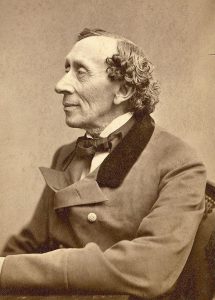
Danish author Hans Christian Andersen was born on this day 219 years ago. He wrote novels, plays, poetry, and travelogues over the course of his seventy-year life, but he is best remembered for creating fairy tales like "The Little Mermaid," "The Snow Queen," "The Ugly Duckling," and "The Red Shoes."
Andersen was born into poverty and lost his father when he was eleven years old. At age fourteen, he left home for Copenhagen, where he was determined to become an actor. For a while, he showed promise as a singer, but when his voice changed, those prospects dimmed. He was sent to a grammar school in Slagelse where he took up writing. He published his first short story, "The Ghost at Palnatoke's Grave," while still in his teens. His school years were mostly unhappy and in subsequent years, he struggled to find success with his writing. However, he was given a modest travel grant by King Frederick VI in 1833, enabling him to travel Europe for a few years.
Major success finally arrived when Andersen published his first novel, The Improvisatore (1835), to immediate success. Andersen's first collection of original fairy tales would be published soon after in 1835. Though he would continue to write in other genres, his fairy tales cemented his fame. In the 1840s, non-Danish audiences also became exposed to his work in translation and Andersen became internationally popular. He befriended other authors such as Charles Dickens. (Infamously, he visited Dickens' home in England and overstayed his welcome for five weeks, much to the chagrin of the Dickens family.) Starting in the 1830s, Andersen was paid a stipend by the Danish government for being a "national treasure." He spent a great deal of time traveling. He died from liver cancer in 1875.
Andersen's stories reflect his appreciation of beauty and the constant feeling that he was perpetually an outsider. His prose style tended to be direct and close to the rhythms of spoken everyday language. Some of Andersen's stories could be quite gruesome, with characters punished for what seem to be minor indiscretions, such as the fate of the heroine of "The Red Shoes." Regardless of that inherent melancholy, his stories often feature a sense of humor as well and even the more tragic stories have silver linings, such as the heroine of "The Little Mermaid" becoming a "daughter of the air" due to her good heart instead of sea foam after she fails to secure the love of her beloved human prince.
Andersen's fairy tales have left behind a rich legacy. Countless artists in a variety of mediums have been inspired by the stories. It is true that many use the original texts merely as a jumping off point, as in the case of Disney's The Little Mermaid and Frozen (a loose adaptation of "The Snow Queen"). Regardless, Andersen's fairy tales remain as haunting and moving as they were two centuries ago.
Hans Christian Andersen was a prolific Danish writer best remembered for his fairy tales. Below are some resources about his life and work, as well as illustrated editions of his beloved stories, and films based on the man and his writing.


Add a comment to: Hans Christian Andersen’s 219th birthday